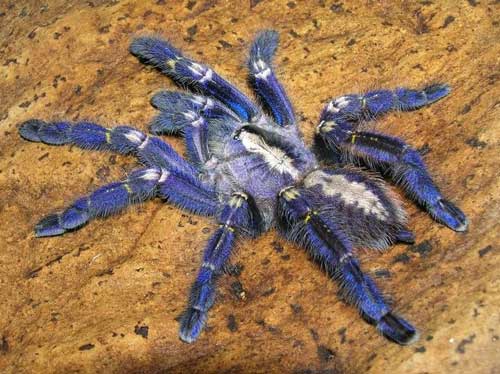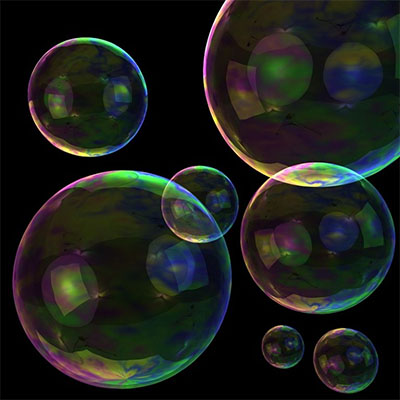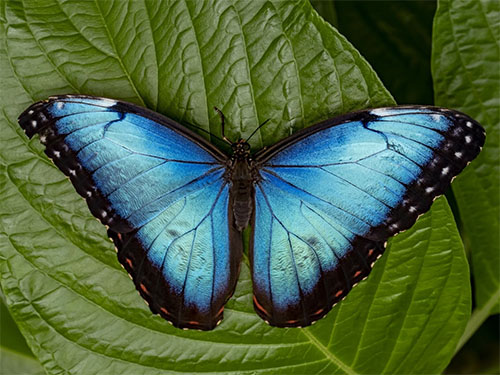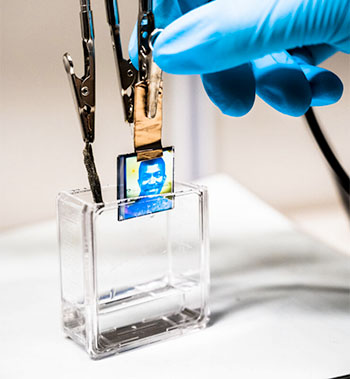| Aug 08, 2023 | |
The nanoscale magic of structural colors |
|
|
Contents
|
|
| (Nanowerk Spotlight) Often, when we marvel at the vibrant colors of the natural world, we overlook the intricate nanoscale structures responsible for producing such splendor: welcome to the world of structural colors. Unlike the pigmented hues we're more accustomed to, structural colors arise from nanostructures interacting with light. This fascinating natural phenomenon relies on the physical properties of light and its dance with tiny, repeating structures on the nanometer scale. In this article, we'll unravel the science behind structural colors and spotlight some of nature's most dazzling displays. | |
 |
|
| The color of the blue tarantula (Poecilotheria metallica) comes from precisely arranged nanocrystals. The crystalline array acts like a mirror that reflects only a particular wavelength of incoming light. In some tarantulas, that wavelength happens to be the same shade of blue. (Image: Tom Patterson) | |
What are structural colors? |
|
| At its core, structural colors are hues produced not by pigments, but by microscopic surface structures that selectively reflect or scatter specific wavelengths of light. Pigments are molecules that absorb certain wavelengths and reflect others, generating color through this selective absorption, which removes certain colors from white light. For example: Chlorophyll absorbs blue and red light, reflecting green - which is why leaves appear green; carotenoids absorb blue light, reflecting yellow and red, giving carrots and tomatoes their color. | |
| In contrast, the colors produced by nanostructures arise from the physical interaction of light waves with the structured surface, without any absorption. Because there is no absorption of light involved as with traditional pigments, the resulting colors can be incredibly vibrant and dynamic. | |
| These colors can be found across a spectrum of living organisms— from plants to animals and especially in insects. The outcome? Iridescent, shimmering optical effects that change based on the angle of view or illumination. The magic behind these colors lies in the constructive and destructive interference of light waves, determined by the dimensions and orientation of the nanostructures. | |
|
|
|
How to make structural colors? |
|
| While nature has perfected the art of structural colors through eons of evolution, researchers are unraveling the mysteries behind these mechanisms and learning to recreate them synthetically. So how exactly can we make structural colors in the lab? Here are some of the key techniques: | |
| Self-Assembly – Rather than direct fabrication, molecules or nanoparticles can be designed to self-assemble into periodic arrays through chemical interactions. This provides a bottom-up approach to making structures like colloidal photonic crystals. | |
| For instance, researchers have demonstrated a feasible solution for producing structural colors by self-assembling nanoparticles with synthetic melanin ("Scalable process discovered to produce structural colors inspired by bird feathers"). | |
| Structural ‘supraball’ pigments could transform cosmetics and food. | |
| Bio-Replication – Natural structural color systems can be analyzed through microscopy and spectroscopy. This understanding guides nanofabrication to directly replicate the biological structures, often using materials like titanium dioxide. | |
| Computational Design – Using simulations and optimization algorithms, novel nanostructures with tailored optical properties can be conceived computationally before fabrication. This expands the design space beyond natural examples. | |
| Hybrid Strategies – Combining top-down nanofabrication, bottom-up self-assembly, and computational modeling enables sophisticated and scalable manufacturing of artificial structural colors. | |
| The field of fabricating structural colors is rapidly accelerating. As nanotechnology and synthesis techniques mature, we inch closer to mass-producing some of nature's most vivid colors and intricate optical designs in the lab. The future looks bright for integrating structural color into a myriad of technologies. | |
The science of structural colors: delving into the nanoscale |
|
| To truly appreciate the magic behind these colors, one must dive deep into the nanoscale world and explore how light interacts with these structures. It's here that the wavelength of light determines the color we perceive. Nanostructures, depending on their design, selectively reflect specific wavelengths. | |
Diffraction |
|
| When light encounters an obstacle, particularly if it's of a size comparable to the light's wavelength, the light waves bend and spread, a phenomenon known as diffraction. This can lead to various color patterns due to the manner in which light waves interfere with each other post-diffraction. The best analogy is perhaps how a prism disperses sunlight into a rainbow of colors. But with diffraction, the play of colors emerges not because light is passing through a medium, but due to its bending around an obstacle. The colorful halos often observed around streetlights in a foggy environment are a classic everyday example of diffraction. In nature, this concept is evident in the dazzling hues of peacock feathers. The microscopic grooves and ridges in the feathers cause light to diffract and interfere, leading to the radiant displays of color. | |
Thin-film interference |
|
| Soap bubbles shimmering in sunlight or an oil slick's rainbow on a wet road are everyday examples of thin-film interference. When light reflects off surfaces with alternating refractive indices, it leads to overlapping light waves. These waves can either amplify certain colors (constructive interference) or nullify them (destructive interference), depending on their phase relationship. The precise thickness of these films and their refractive properties determine the resulting colors. Nature exploits this phenomenon magnificently. Certain beetles, for instance, owe their vibrant shells to the thin layers in their exoskeletons which cause light waves to interfere and produce vivid colors. | |
 |
|
| Birds, fish, insects, some plants and berries, soap bubbles, rainbows and more have colours that result from the partial reflection of light waves. (Image: Colourbox) | |
Photonic crystals – nature's tiny reflectors |
|
| Photonic crystals represent a marvel of natural nanotechnology. They are unique structures with a periodic arrangement on the nanoscale, influencing how photons (light particles) move through them. Their architecture results in photonic band gaps – analogous to electronic band gaps in semiconductors that define which electron energies are allowed or forbidden, photonic crystals have photonic band gaps, determining which light wavelengths (colors) can pass and which are reflected. | |
| Imagine a sieve that lets through specific grains of sand based on their size. Similarly, photonic crystals control the colors we perceive. The iridescence of some butterfly wings is attributed to such structures. The microscopic scales on these wings have an ordered, lattice-like structure that selectively reflects certain colors, leading to their magnificent hues. | |
| By manipulating the periodicity and structure of these crystals, it's possible to control the colors of light they reflect. Examples in nature include the vibrant colors of some butterfly wings, which are not due to pigments but because of the photonic crystal-like structures that reflect specific wavelengths of light. | |
Playing with light waves: Diffraction and interference combined |
|
| Light waves are rhythmic, possessing peaks and troughs. When they navigate the intricate, nanoscale patterns found on some surfaces, these waves can be bent, split, or even made to overlap. Diffraction often acts as a prelude to interference patterns, with the bent waves subsequently interacting in ways that either amplify or nullify certain colors. | |
| Nature's canvas is replete with examples where these phenomena are intertwined. The iridescence of peacock feathers or the shimmer on certain beetles can be attributed to a combination of diffraction and interference, producing a dance of colors that captivate the observer. | |
Multilayers and interference |
|
| Nature often goes beyond just a single thin film to achieve its symphony of colors. Through a series of multilayers, each causing interference, a dynamic and vibrant color display emerges. Each layer reflects a portion of light, and when these reflections combine, they produce colors that can change based on the viewing angle. | |
| The Morpho butterfly provides a classic example. Its wings, devoid of any blue pigment, manage to exhibit a radiant blue. This is a result of the multiple nano-layers within the wing scales. These layers cause light waves to interfere and produce the striking blue color, which varies in intensity and hue based on the angle of light and observation. | |
 |
|
| A blue morpho butterfly sits on a leaf. (Image: Kristen Grace, Florida Museum) | |
| Together, these phenomena showcase the stunning complexity and beauty of the natural world. By understanding them, we not only appreciate nature more but also unlock potential avenues for technological innovation. | |
Potential applications in technology and design |
|
| The understanding of structural colors is not just an academic pursuit; it paves the way for innovative applications in our daily lives. | |
Bioinspired design of optical devices, sensors, and displays |
|
| In nature, many organisms have evolved sophisticated ways of manipulating light through structural colors, providing inspiration for next-generation optical devices. By mimicking these intricate nanoscale structures, we can design optical devices that are more efficient, compact, and versatile. For instance, sensors that can detect minute changes in light could be used in medical diagnostics, detecting substances at extremely low concentrations. | |
| Similarly, displays inspired by nature's vibrant and dynamic color mechanisms could offer brighter, energy-efficient, and more adaptable screens for electronic devices. The prospect of this bioinspired approach heralds a revolution in how we process and display information, taking cues from millions of years of natural evolution. | |
| For instance, researchers have developed a simple method to produce structural color images with electrically conducting plastics, or conducting polymers ("New displays based on tunable structural colors"). | |
 |
|
| The method produces structural color images with electrically conducting plastics, or conducting polymers. The polymer is applied at nanoscale thicknesses onto a mirror by a technique known as vapour phase polymerisation, after the substrate has been illuminated with UV light. (Image: Thor Balkhed) | |
Color-changing smart fabrics and coatings |
|
| The world of fashion and decor is on the brink of a major transformation. Imagine fabrics that change color based on the weather, mood, or even the event you're attending. Using the principles of structural colors, researchers are developing materials that interact with their surroundings in dynamic ways. This technology goes beyond aesthetics; such fabrics can also provide functional benefits. For example, a jacket could turn white under intense sun to reflect heat and turn dark in cooler environments to absorb warmth. These smart fabrics and coatings are not just the future of fashion but a step towards interactive and adaptive material design. | |
Anti-counterfeiting tools leveraging structural colors |
|
| Counterfeiting remains a persistent challenge for global economies. Traditional methods of security, like watermarks or holograms, are increasingly being replicated by advanced counterfeiting techniques. Structural colors, with their complexity and specificity, offer a promising solution. By embedding documents and banknotes with structural color patterns, which are incredibly difficult to replicate without exact nanoscale structures, we can add a layer of security that's both visible and verifiable. As a result, banknotes, official documents, and even product labels could be made far more secure against forgery. | |
Enhanced solar cells and LEDs |
|
| Light manipulation lies at the heart of solar cells and LEDs. Harnessing the principles of structural colors, we can vastly improve the efficiency of these devices. For solar cells, structures mimicking the ones found in nature could lead to more efficient light absorption, increasing energy capture even in low-light conditions. On the other hand, LEDs, which emit light, could be designed to produce brighter and more vivid colors with less energy. This approach not only promises to enhance the capabilities of these devices but also makes them more sustainable and energy-efficient. | |
Sustainable colorants and coatings |
|
| The environmental and health impacts of synthetic dyes and pigments are becoming increasingly concerning. However, if we could replicate the vibrant, non-fading colors produced by structural mechanisms in nature, we could usher in a new era of sustainable coloration. These bioinspired colorants, free from harmful chemicals, would not only be eco-friendly but also resistant to fading over time, making them ideal for various applications, from textiles to paints. | |
Advanced optical devices |
|
| Nature's mastery over light manipulation, honed over eons, is a treasure trove for optical research. Scientists are now borrowing designs from organisms like butterflies and beetles to craft advanced optical devices. These devices, whether they're lenses, sensors, or other instruments, promise unmatched capabilities—be it in terms of sensitivity, resolution, or adaptability. This bioinspired approach could revolutionize fields ranging from microscopy to telecommunications. | |
Wearable tech and fashion |
|
| The confluence of fashion and technology has birthed a realm of possibilities. Designers, armed with an understanding of structural colors, are crafting apparel that responds to environmental cues. Such clothing could change hues based on temperature, light conditions, or even air quality. Beyond mere aesthetics, these garments could also provide wearers with information about their surroundings or their physiological state. The frontier of wearable tech now stands poised to redefine our relationship with clothing, making it interactive, adaptive, and informative. | |
3D and 4D printed color changing elements |
|
| 4D printing with stimuli-responsive materials enables 3D printed structures to change its configurations over time and is used in a wide variety of fields such as soft robotics, flexible electronics, and medical devices. This concept can be extended to structurally colored inks. For instnce, researchers have developed a humidity-responsive color changing ink for extrusion 3D printing ("Towards 4D printing with structural colors"). | |
A bright future for structural color research |
|
| From the delicate shimmer of a butterfly's wings to the breathtaking advancements in our technological landscape, the enigma of structural colors showcases the boundless promise nestled within the nanoscale universe. While we have begun to scratch the surface, the intricacies of these natural mechanisms continue to captivate researchers. As we delve deeper, unraveling the myriad ways nature manipulates light, we stand on the cusp of pioneering even more transformative applications. | |
| Technological facets, such as optimizing light absorption in solar devices, crafting adaptive wearables, or even developing advanced optical storage, could be redefined with insights from structural colors. Furthermore, as we push the boundaries of our understanding, nascent areas of research beckon — like integrating these nanoscale marvels with quantum computing or biotechnological applications. | |
| Undoubtedly, as we journey forward, the kaleidoscopic wonders of the nanorealm will fuel our curiosity, creativity, and drive for innovation, shaping a future where nature's playbook guides our next technological renaissance. | |
Frequently Asked Questions (FAQs) about structural colors |
|
How are structural colors different from pigment colors?
While pigment colors arise from the absorption of certain wavelengths of light, structural colors result from the interaction of light with specific nanostructures.
Why do some organisms have structural colors?
From attracting mates to camouflage, structural colors can offer advantages in survival and reproduction.
Can humans produce structural colors artificially?
Yes, with advances in nanotechnology, we're increasingly able to harness the principles behind structural colors for various applications.
Are structural colors eco-friendly?
In many potential applications, such as sustainable dyes and coatings, structural colors can offer eco-friendly alternatives to traditional materials.
Can structural colors fade over time?
Structural colors may fade if the nanostructures generating them are damaged. But they are generally more durable than pigment colors which degrade through chemical changes.
How do researchers study and design structural colors?
Advanced microscopy reveals nature's structural color designs which are then mimicked using nanofabrication tools. Computer modeling also facilitates predicting optical effects.
What potential industries stand to benefit from advancements in structural colors?
Beyond the obvious realms of fashion and design, industries like aerospace, medicine, electronics, and environmental sustainability could harness the advantages of structural colors for enhanced performance and eco-friendliness.
Does the production of artificial structural colors require expensive technology or processes?
While initial research and nanofabrication tools can be costly, as techniques mature and scale up, the costs are expected to decrease, making structural colors more accessible for various industries.
Are there any potential challenges or limitations to using structural colors in technology?
Like any technology, challenges exist. Fine-tuning structural colors for specific applications, ensuring their longevity in various environments, and scaling up their production are some of the hurdles researchers and industries are currently addressing.
Are structural colors found in organisms beyond birds and butterflies?
Absolutely! Various marine organisms, certain plants, and even some mammals exhibit structural colors, showcasing nature's vast and diverse application of this phenomenon.
|
|
 By
Michael
Berger
– Michael is author of three books by the Royal Society of Chemistry:
Nano-Society: Pushing the Boundaries of Technology,
Nanotechnology: The Future is Tiny, and
Nanoengineering: The Skills and Tools Making Technology Invisible
Copyright ©
Nanowerk LLC
By
Michael
Berger
– Michael is author of three books by the Royal Society of Chemistry:
Nano-Society: Pushing the Boundaries of Technology,
Nanotechnology: The Future is Tiny, and
Nanoengineering: The Skills and Tools Making Technology Invisible
Copyright ©
Nanowerk LLC
|
|
|
Become a Spotlight guest author! Join our large and growing group of guest contributors. Have you just published a scientific paper or have other exciting developments to share with the nanotechnology community? Here is how to publish on nanowerk.com. |
|
